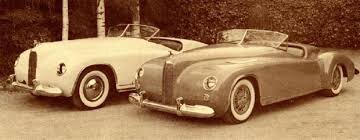Maverick Sportster
Note: This piece is currently a work in progress
John Bond, founder of Road & Track magazine, once described a sports car as being “built for sports motoring, rather than mere transportation, with higher than average construction and engineering, preferably with 2 seats and open bodywork.” Using that definition, it is hard to say if the Maverick could be called a sports car. It is an open 2-seater, and it sure as hell isn’t mere transportation. But what the hell. This car is way too cool not to include.
Maverick Sportster (www.Kustomrama.com)
The Maverick Sportster was created by H. Sterling “Smoke” Gladwin, a retired aeronautical engineer from Mountain View, California. Gladwin had worked for Boeing and Lockheed, where during the war he helped develop the triggering device for the atomic bomb, and later for NASA. In his spare time Smoke was a hotrodder, too. He modified a 1937 Terraplane to hit 113mph at Muroc dry lake. A very smart man with a fierce curiosity, he became interested in fiberglass. Starting with a chassis and drivetrain from a 1940 LaSalle, Gladwin spent nearly 1200 hours crafting a voluptuous boattail roadster of gargantuan proportions. At 16 feet long and 6 feet wide, it was the world’s largest fiberglass bodied car.
((www.Kustomrama.com))
Pleased with the prototype, Smoke Gladwin was encouraged by the attention the Maverick received wherever it went. He decided to go ahead with the Maverick in 1954. The production version used a period Cadillac Eldorado chassis. Weighing in at 3100lbs, the 210hp Cadillac OHV V8 could propel what Gladwin called his “land-based Pegasus” to 130mph. Promotional materials described it as “An all-Western long range commuter for the Western highways.” Thinking of using one as your daily driver? Think again. The Maverick offered on top, nor even windshield wipers.
(www.UndiscoveredClassics.com)
Bodies were fabricated by Industrial Plastic Services of Oakland, CA, with the final assembly done down the peninsula in Los Altos. They were priced from $3850 to $5440 depending on the engine. A total of 6 Maverick Sportsters (in addition to the prototype, plus a few bodies) were built before Gladwin called it quits in 1968. At least two Mavericks exist today (though rumors tell of 2 or 3 others out there) The original was spectacularly restored by Fred Roth, noted collector of post-war American sports cars.
The original (www.VCStar.com)
Some years after he had sold the rights to the Maverick name to the Ford Motor Company for their upcoming compact, he told John Lamm in an interview with Special Interest Auto, that he was “sorry to see his name on the nose of such a tin can.” Argue all you want whether the Maverick is really a sports car, but it is sure no tin can.
Copyright@2020 by Mal Pearson
Source and Further Reading
Land Based Pegasus, Motor Trend Classic, June 3, 2014, by Ken Gross




